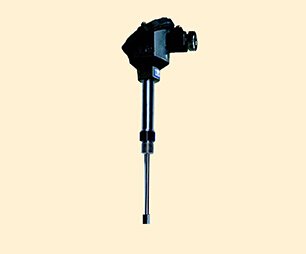
Working Principle
The knife-edge thermocouple is a surface-contact temperature sensor designed to measure the outer wall temperature of boiler tubes or furnace pipes. It operates on the Seebeck effect, where a thermoelectric voltage is generated at the junction of two dissimilar metals based on the temperature difference between the measuring and reference ends.
Unlike insertion-type thermocouples, this sensor features a blade or knife-shaped sensing tip, which allows it to tightly contact the curved surface of a boiler tube. This design improves thermal conduction, ensuring accurate, real-time surface temperature measurements without breaching the tube wall.
Applications
Knife-edge thermocouples are used in high-temperature, high-pressure boiler systems, especially where internal access is limited or non-intrusive monitoring is required. Typical application fields include:
- Thermal power plants – For boiler tube temperature monitoring
- Petrochemical refineries – Monitoring furnace coil surfaces
- Industrial boilers and superheaters – For wall temperature control
- Steel and glass manufacturing furnaces
- Waste heat recovery systems
- Steam reformers and cracking furnaces
This sensor is essential for preventing overheating, tube rupture, or thermal fatigue failure.
Materials and Construction
- Sensing Element
- Thermocouple types: Type K, N, J, or E (based on temperature and process compatibility)
- Constructed for high sensitivity and fast response.
- Knife-edge Tip / Blade Contact Surface
- Made from hardened stainless steel, Inconel 600/601, or nickel-based alloys
- Designed to fit curved boiler tube surfaces with stable thermal contact.
- Protective Sheath
- 304/316L Stainless Steel, Inconel, or ceramic-coated versions
- Corrosion-resistant and heat-resistant up to 800–1100°C, depending on material.
- Cable / Insulation
- Mineral Insulated (MI) Cable with magnesium oxide insulation
- Durable in high-temperature and vibration-heavy environments.
- Mounting / Attachment Options
- Spring-loaded clamps, weld-on brackets, or strapped assemblies
- Designed for easy installation, alignment, and removal
- Terminal Head / Signal Output
- Explosion-proof or waterproof head available
- Optional integration with temperature transmitters (4–20 mA / HART) for signal conditioning.
Technical Features & Benefits
- Non-intrusive surface sensing for safer boiler tube monitoring
- Fast thermal response due to direct contact and high-conductivity materials
- Accurate surface temperature reading without affecting pipe integrity
- Robust construction resists corrosion, oxidation, and mechanical stress
- Customizable design to match tube diameter, process temperature, and mounting preference
- Improves safety by enabling early detection of localized overheating or fouling
